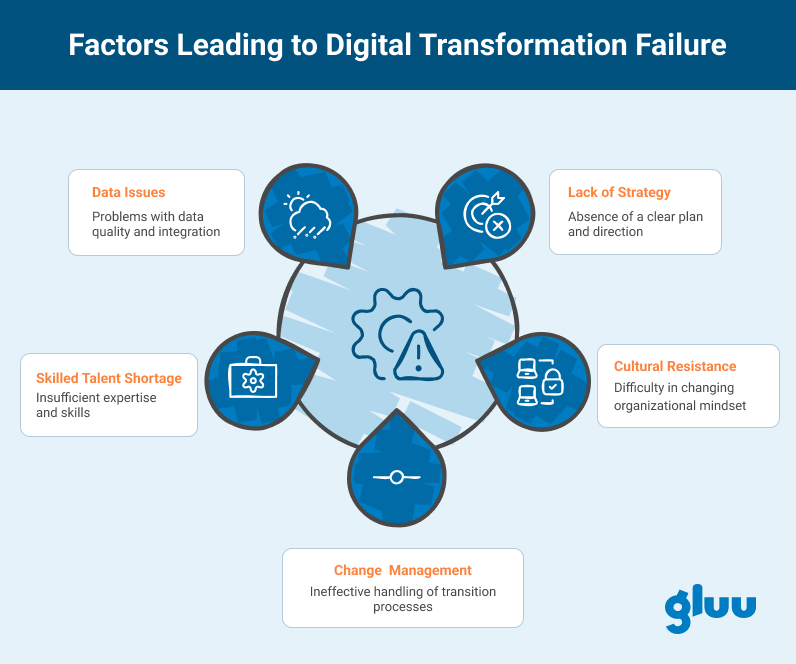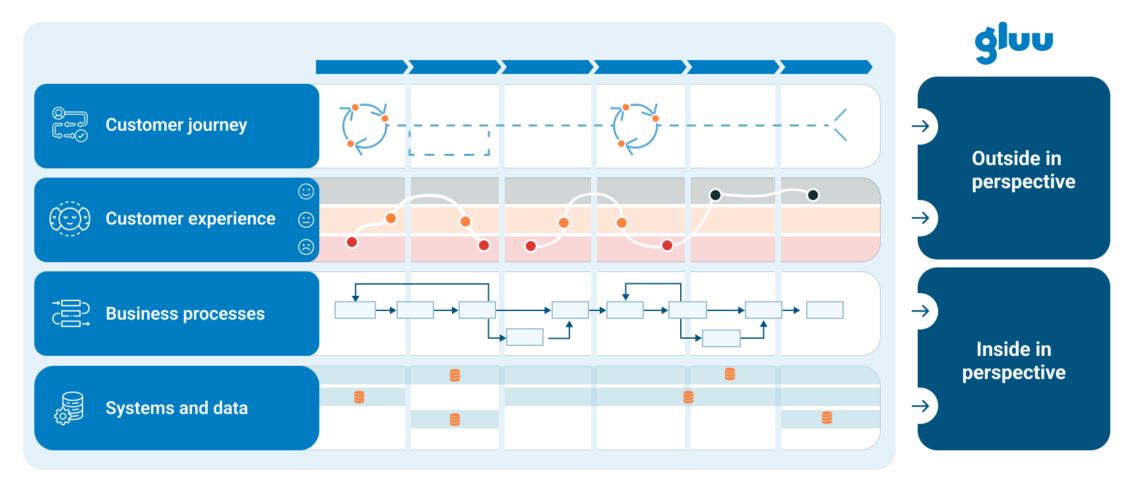
Digital Transformation + Business Process Management = Higher Success Rate

70% of digital transformations fail. With this article I will look into why that is and offer practical ways that business process management (BPM) can be used to lower the failure risk of your company’s upcoming transformation.
Some will now be thinking “But we will do process mapping before we start our digital transformation, so we got it covered.” Most likely no. Too often this means a few work shops to map ideal to-be processes on a whiteboard then redrawing them in Visio and saving them somewhere that few will look. That is not what digital transformation enabled by business process management means. So keep reading to be inspired to use BPM more effectively.
1. Top 5 reasons why digital transformations fail
The failure rate of digital transformations is alarmingly high, with multiple studies estimating that around 70% of these initiatives do not achieve their intended outcomes:
Based on recent studies, here are the top five reasons why digital transformations fail:

1.1 Lack of Clear Strategy and Vision
Many organizations initiate digital transformation without a well-defined strategy or clear objectives. Misaligned goals, insufficient planning, and unclear implementation pathways often lead to projects that fail to deliver expected results. Ensuring alignment between leadership and broader organizational goals is critical.
1.2 Resistance to Cultural Change
Employees and management may resist changes to established workflows and technologies, especially in organizations with entrenched processes. This cultural opposition can hinder the adoption of new systems and practices necessary for transformation.
1.3 Inadequate Change Management
An ineffective or absent change management strategy can cause confusion and disengagement across teams. Effective change management requires clear communication, training, and involvement of all stakeholders to foster acceptance of new technologies and workflows.
1.4 Shortage of Skilled Talent
The success of digital initiatives often hinges on technical expertise, such as data analytics, cybersecurity, and software engineering. Many organizations struggle with talent shortages, leaving them unable to effectively implement and manage digital tools.
1.5 Poor Data Quality and Integration
Digital transformations rely on robust data infrastructure, but many organizations face challenges with incomplete or low-quality data, as well as difficulties in integrating new systems with legacy ones. These issues undermine the foundation needed for effective digital initiatives.
Addressing these challenges requires a focus on strategic planning, fostering a culture of adaptability, ensuring skilled resources are available, and investing in foundational systems like data infrastructure and change management.
2. References and Links
- RAND Corporation’s insights on avoiding AI transformation pitfalls: RAND report
- OECD’s analysis of digital transformation challenges: OECD Digital Transformation
- World Bank’s study on global digital progress and barriers: World Bank Report.
3. How Business Process Management reduces Digital Transformation Risk
Just to summarize, Business Process Management (BPM) is a systematic approach to improving an organization’s processes for efficiency, adaptability, and alignment with business goals. It involves designing, analyzing, optimizing, and automating workflows to enhance performance, reduce costs, and ensure compliance. So why is successful digital transformation often combined with business process management?
The short answer is that BPM bridges the gap between business operations and technology. It simple provides a language for business people to communicate with IT people, and vice versa. Additionally, it shows the relationships between the organization’s ideal customer outcomes and the people, systems and assets that can enable these to be delivered consistently.
Starting on a digital transformation without a business process management foundation is like a building a house without any drawings. A recipe for disaster.
Now let me offer some practical ways that using BPM effectively can lower each of the top 5 reasons why digital transformations fail.
3.1 Break your strategy down into its supporting business processes

Often the vision and strategy for a digital transformation is too vague. In a large organization you must ensure that this is broken down into successful customer outcomes and behind these, you will find the business processes that should enable these outcomes to be delivered.
- Customer journey
- Customer experience
- Business processes
- Systems and data
3.2 Assign Process Owners as change agents to drive the transformation
“People like change they just don’t like being changed.”
Peter Senge
The idea that top management hires a consultancy to drive a digital transformation will lead to resistance. So how do you get staff to drive your change? BPM has an answer. The answer is to delegate process ownership and involve key staff actively as change agents. How can that work?
If you decide to break your strategy down into the level of impacted business processes, then you can suddenly assign multiple owners of different parts of your digital transformation.
You have to give the process owners a clear mandate to improve – or reengineer – your end-to-end processes. This should include the activities, systems, bots and AI agents that will support and transform it.
In turn, process owners can engage other business users to pilot, trial, test and give feedback as processes are gradually improved. Enlisting business users as co-creators will turn them into supporters of your transformation, simply through early and frequent involvement.
3.3 Use processes to transfer knowledge and close the skills gap
Building a hand-made car from start to finish is something that very few mechanics can do. However, being trained to work in a station in a car assembly line is something that most people would be able to. It’s the same with using new technology to e.g. service customers. You must use processes and work instructions to make very clear what is to be done, by whom and how. The better you do this, the more effectively you will be able to transfer knowledge from the people that know to the ones that don’t.
3.4 Business processes increase data quality
Many organizations face challenges with incomplete or low-quality data, as well as difficulties in integrating new systems with legacy ones. This is often the result of years of inconsistent work where people’s work activities were disconnected from data entry forms. For instance, different people used the same fields differently leading due to a lack of a common business process.
4. How to make it practical
So, to truly leverage BPM in your digital transformation you need an integrated tool that allows you to…
- Build an integrated, hierarchical process repository that shows how process outcomes will deliver on your strategy.
- Enable Process Owners to truly map, own and manage each impacted end-to-end process as a community that engages both IT and business users.
- Allow for business users to test processes and provide feedback in a closed loop that minimizes email and meetings.
- Integrate roles, process maps, work instructions and assets to turn your process into interactive guides for work that help with knowledge transfer.
If you don’t have such a tool already, then you should consider Gluu, which is the tool that we create.
For further insights on selecting the right BPM tools to drive your digital transformation successfully, explore our BPM Software Selection Guide.
Here’s an example of how you can use Gluu to lower your ERP project failure risk:
5. Conclusion
Digital transformations often fail due to unclear strategies, resistance to cultural change, poor change management, talent shortages, and inadequate data integration. Combining digital transformation with Business Process Management (BPM) can significantly reduce these risks. BPM aligns business goals with technology, fostering better communication, assigning clear process ownership, and actively involving staff as change agents. It also helps standardize processes to improve data quality, bridge skill gaps, and ensure consistent outcomes. By effectively leveraging BPM, organizations can navigate the complexities of digital transformation more successfully and achieve their intended goals. However, to realize this in practice you need a BPM tool that can engage business users effectively.



